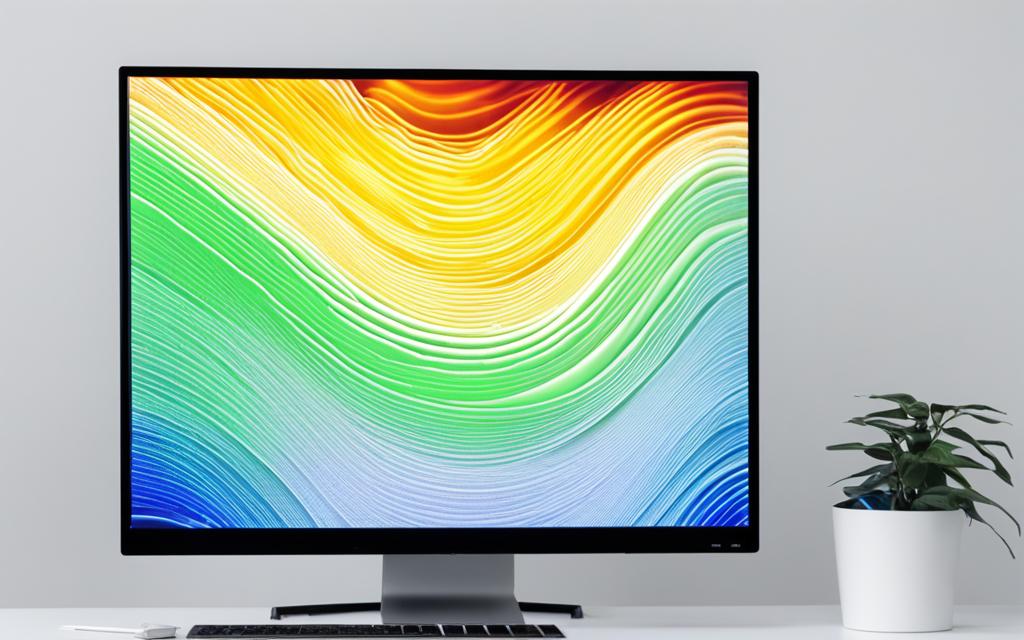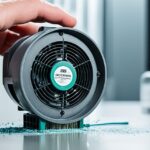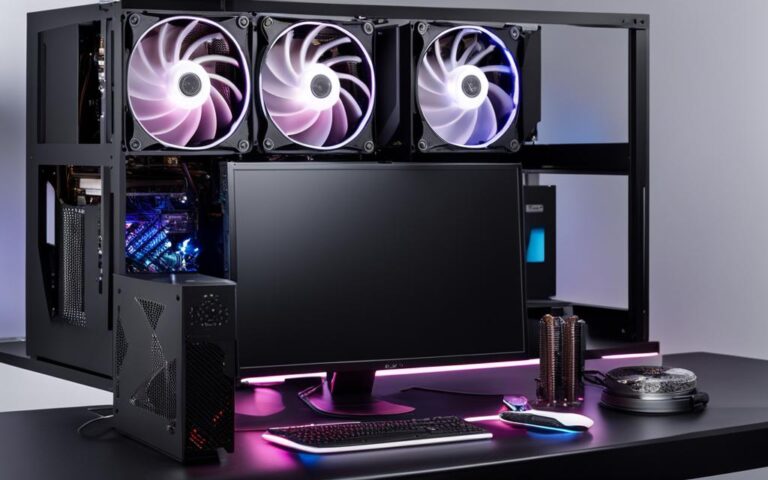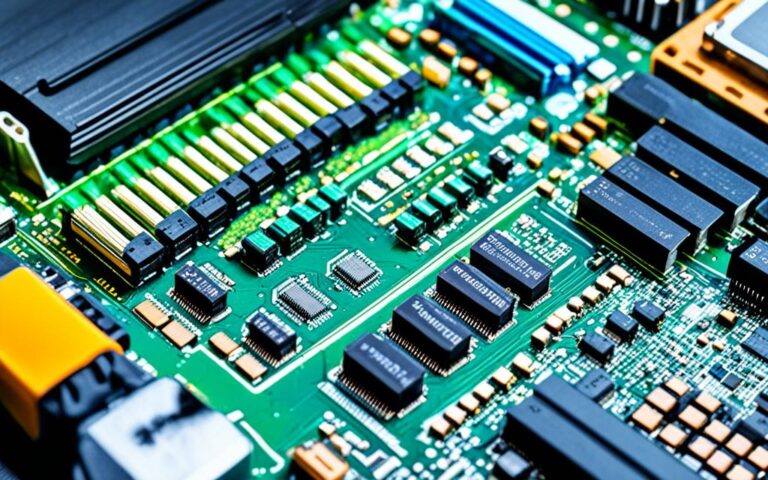Addressing Desktop Thermal Throttling Issues
Are you experiencing desktop overheating issues that are impacting your system’s performance? Thermal throttling can be a common problem that arises when your system’s CPU becomes too hot, leading to reduced performance and potential damage. In this article, we will explore thermal throttling solutions specifically tailored for UK users, helping you combat desktop overheating and optimize your system’s performance.
Thermal throttling can occur in both PCs and laptops, and it’s crucial to address this issue to ensure that your system runs smoothly and efficiently. We’ll delve into what thermal throttling is and how it differs from CPU throttling, which is a normal function of processors. By understanding the effects of thermal throttling and how to identify and manage it, you can overcome this challenge and enjoy a seamless computing experience.
Understanding CPU Throttling and Thermal Throttling
CPU throttling and thermal throttling are terms commonly used in relation to processor performance and temperature management. While they may sound similar, there are important distinctions between the two.
CPU throttling, also known as Dynamic Frequency Scaling, is a technique employed by processors to optimize efficiency. It involves balancing clock speeds, power draw, and operating temperatures to achieve an optimal performance level. By dynamically adjusting the clock speed, the processor can respond to workload demands and conserve power when full performance is not required.
On the other hand, thermal throttling occurs when a CPU is forced to throttle its performance due to inadequate temperature management. When a processor reaches its safe operating temperatures, it automatically reduces its clock speed to prevent overheating. This action is taken to protect the processor from potential damage caused by high temperatures.
It’s important to note that CPU throttling is a normal and intentional function of processors, designed to optimize performance and power consumption. Thermal throttling, on the other hand, is an indication of inadequate cooling or ventilation, resulting in reduced performance and potential long-term damage.
The Role of Dynamic Frequency Scaling
Dynamic Frequency Scaling, or CPU throttling, is an integral part of modern processor technology. It allows the processor to adapt its performance to meet the demands of various tasks. By dynamically adjusting the clock speed and voltage, the processor can balance the power draw and heat generation, optimizing performance and energy efficiency.
The Impact of Thermal Throttling
Thermal throttling is a clear indication of inadequate cooling and can have significant implications for system performance. When a CPU thermally throttles, its clock speed is reduced, leading to decreased performance in CPU-intensive tasks. This can result in slower processing speeds, increased response times, and even system instability.
Furthermore, thermal throttling is a warning sign of potential overheating issues that need to be addressed. Operating a processor at consistently high temperatures can lead to premature aging and component degradation, affecting the overall lifespan of the system.
Safe Operating Temperatures and Power Draw
To maintain optimal system performance and prevent thermal throttling, it is essential to ensure that the CPU operates within safe temperature limits. The safe operating temperature range for CPUs varies depending on the manufacturer and model. However, it is generally recommended to keep the CPU temperature below 80°C for most desktop processors.
In terms of power draw, excessive power consumption can lead to increased heat generation, exacerbating thermal throttling. It is important to consider the power requirements of the system’s components and ensure an adequate power supply that can handle the power draw of the CPU under heavy workloads.
Effects of CPU Throttling and Thermal Throttling
CPU throttling, although not necessarily bad, can have a significant impact on system performance. One of the main effects of CPU throttling is decreased performance, which can be particularly noticeable in gaming scenarios. When the CPU is throttled, it operates at lower clock speeds, resulting in lower framerates and reduced overall performance.
On the other hand, thermal throttling not only affects performance but can also indicate a broader issue with the system’s cooling solution. When the CPU temperature reaches a certain threshold, it triggers thermal throttling to prevent the system from overheating. This is an important protective measure, but it can cause performance degradation.
However, thermal throttling can also have more severe consequences. When a system experiences poor thermals, it can lead to frequent system shutdowns as a safety measure to prevent damage. This can be disruptive, especially during important tasks or while playing games. Additionally, thermal throttling puts the CPU at risk of long-term damage if left unaddressed.
To optimize system performance and prevent potential damage, it is crucial to address both CPU throttling and thermal throttling. By implementing effective cooling strategies and ensuring proper airflow, users can minimize the impact of thermal throttling and maintain optimal system performance.
**Table**: Comparative Performance Impact of CPU Throttling and Thermal Throttling
| Effects | CPU Throttling | Thermal Throttling |
|---|---|---|
| Decreased Performance | ✓ | ✓ |
| Lower Framerates | ✓ | |
| System Shutdowns | ✓ | |
| Potential Damage to Processor | ✓ |
As seen in the table above, both CPU throttling and thermal throttling have an impact on performance. While CPU throttling primarily affects performance and framerates, thermal throttling can lead to system shutdowns and potential damage to the processor. It is important for users to proactively address these issues to optimize system performance and prevent long-term damage.
Identifying CPU Throttling
To ensure optimal system performance, it is crucial to identify whether your CPU is experiencing throttling. By checking for CPU throttling, you can address the issue and prevent potential decreases in system performance and productivity workloads. Fortunately, there are tools available, such as the Windows Resource Monitor, that can help you determine if your CPU is throttling under certain circumstances.
The Windows Resource Monitor provides valuable insights into your CPU’s performance. By monitoring the maximum frequency of your CPU relative to its base clock speed, you can effectively detect if your CPU is throttling. If the percentage of the maximum frequency appears to cap out at a given value, it indicates CPU throttling is occurring.
Identifying CPU throttling is essential as it directly impacts system performance. Throttling hampers the CPU’s ability to operate at optimal power and speed, resulting in decreased performance, slower application response times, and potential productivity limitations.
“The Windows Resource Monitor is a powerful tool for monitoring system performance and diagnosing performance issues. By utilizing this tool, you can identify if your CPU is throttling and take appropriate actions to optimize system performance.”
Steps to Identify CPU Throttling using Windows Resource Monitor:
- Launch the Windows Resource Monitor by opening the Start menu and searching for “Resource Monitor”.
- In the Resource Monitor window, navigate to the “CPU” tab.
- Observe the “Maximum Frequency” column, which displays the CPU’s current frequency as a percentage of its maximum capability.
- If the maximum frequency value consistently stays capped at a specific value, it suggests that your CPU is experiencing throttling.
By following these steps and monitoring your CPU’s maximum frequency using the Windows Resource Monitor, you can accurately identify if CPU throttling is affecting your system performance. This knowledge empowers you to take appropriate measures to address the issue, optimize your system, and ensure smooth and efficient operation.
| Signs of CPU Throttling | Potential Impact on System Performance |
|---|---|
| The CPU’s maximum frequency consistently caps at a specific value | Decreased performance and slower application response times |
| The CPU’s temperature rises significantly during intensive workloads | Potential system instability, crashes, and data loss |
| Visible performance drops or stutters during demanding tasks | Reduced productivity and limitations in multitasking |
Managing CPU Throttling
To prevent CPU throttling and ensure optimal performance, it is essential to make adjustments to the Windows Power Plan settings. By selecting the High Performance Power Plan, you can avoid CPU throttling and allow your processor to operate at its maximum potential.
Optimizing the Minimum and Maximum Processor State Policies to 100% is another crucial step in preventing CPU throttling. By doing so, you ensure that the CPU remains consistently active, without any reduction in clock speed or performance.
Furthermore, it is crucial to check and adjust the System Cooling Policy. Proper utilization of system fans is essential for efficient cooling and prevention of overheating, which can lead to CPU throttling. By ensuring that the fans operate at their optimal speed, you can effectively manage the heat generated by the CPU.
Make sure to monitor your CPU’s temperature regularly and employ proper cooling measures, such as adding additional fans or upgrading the cooling system, if necessary. Maintaining a consistently low temperature is key to preventing CPU throttling and ensuring uninterrupted performance.
Remember that preventing CPU throttling not only enhances your system’s performance but also extends its lifespan, making it a worthwhile investment of your time and effort.
| Actions | Benefits |
|---|---|
| Adjust Windows Power Plan to High Performance | Prevents CPU throttling and maximizes processor performance |
| Optimize Minimum and Maximum Processor State Policies to 100% | Maintains constant CPU activity without reduction in performance |
| Check and adjust the System Cooling Policy | Ensures efficient utilization of system fans and prevents overheating |
| Monitor CPU temperature regularly | Enable early detection of potential thermal issues |
Checking for Thermal Throttling
To check if your CPU is experiencing thermal throttling, you can utilize a hardware monitoring tool like CPUID HWMonitor. This tool provides valuable insights into the temperature conditions of your CPU, allowing you to assess whether thermal throttling is occurring. By comparing the CPU temperature metrics, including the current, minimum, and maximum values, with the manufacturer’s specifications, you can determine if your CPU is operating within safe temperature limits or if it is being subjected to thermal throttling.
Monitoring your CPU temperature is crucial, as high temperatures can be indicative of thermal throttling issues. If you observe consistently high temperatures while your CPU is idle or encountering demanding workloads, it signifies a potential thermal problem that needs to be addressed promptly.
By closely monitoring CPU temperatures with a reliable tool like CPUID HWMonitor, you can stay informed about your system thermals and identify any abnormal temperature fluctuations that may jeopardize the performance and longevity of your CPU.
One way to visually check for thermal throttling is to observe the CPU temperature graph provided by the monitoring tool. If you notice recurring temperature spikes followed by drops, it suggests that the CPU is entering a thermal throttling state to safeguard itself from overheating.
Preventing Thermal Throttling
To prevent thermal throttling and ensure optimal performance, it is crucial to address the underlying causes of overheating. By implementing the following measures, you can effectively manage CPU temperature and prevent thermal throttling:
- Ensure proper airflow: Adequate airflow is essential to dissipate heat from the CPU and other components. Make sure that your desktop has sufficient ventilation, and avoid obstructing air intake and exhaust vents. Keeping the surroundings clean and dust-free can also improve airflow.
- Clean or replace fans: Over time, dust and debris can accumulate on CPU fans, impeding their effectiveness. Regularly clean the fans with compressed air or a soft brush to remove any buildup. If the fans are worn out or malfunctioning, consider replacing them to ensure efficient cooling.
- Correctly mount the CPU heatsink: The CPU heatsink plays a critical role in dissipating heat. Ensure that it is securely mounted onto the CPU with thermal paste for optimal heat transfer. Follow the manufacturer instructions carefully when installing or reseating the heatsink.
- Re-paste the CPU: Over time, the thermal paste between the CPU and heatsink may dry out or degrade, causing inadequate heat transfer. Repasting the CPU with high-quality thermal paste can help improve thermal conductivity and reduce temperatures effectively.
- Invest in SSDs with heatsink technology: Solid State Drives (SSDs) with integrated heatsinks, such as the Samsung 980 Pro with Heatsink, can provide enhanced cooling capabilities. These specialized SSDs help dissipate heat generated during heavy workloads, preventing thermal throttling and maintaining optimal performance.
By implementing these measures, you can effectively prevent thermal throttling, keep CPU temperatures in check, and optimize the performance and longevity of your desktop system.
Conclusion
Thermal throttling can have a significant impact on the performance and longevity of your desktop system. To combat desktop overheating and optimize system performance, it is crucial to understand and address both CPU and thermal throttling issues. By implementing the right solutions, you can ensure that your desktop operates at its full potential.
Adjusting the Windows Power Plan is an effective way to optimize system performance and prevent CPU throttling. By selecting the High Performance Power Plan and optimizing the Minimum and Maximum Processor State Policies to 100%, you can ensure that your CPU operates at its maximum frequency, resulting in improved performance.
To address thermal throttling, it is important to check for overheating and take appropriate measures. Using a hardware monitoring tool, such as CPUID HWMonitor, you can monitor your CPU temperature and compare it to the manufacturer’s specifications. Regularly cleaning or replacing fans, properly mounting the CPU heatsink, and applying high-quality thermal paste can help prevent overheating and reduce the risk of thermal throttling.
In the UK, where users may experience unique environmental and usage conditions, it is vital to tailor thermal throttling solutions accordingly. By implementing these thermal throttling solutions, you can combat desktop overheating, optimize system performance, and ensure that your desktop operates at its best for years to come.












